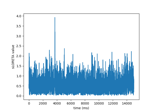mne.minimum_norm.apply_inverse_raw#
- mne.minimum_norm.apply_inverse_raw(raw, inverse_operator, lambda2, method='dSPM', label=None, start=None, stop=None, nave=1, time_func=None, pick_ori=None, buffer_size=None, prepared=False, method_params=None, use_cps=True, verbose=None)[source]#
Apply inverse operator to Raw data.
- Parameters:
- raw
Rawobject Raw data.
- inverse_operator
dict Inverse operator.
- lambda2
float The regularization parameter.
- method“MNE” | “dSPM” | “sLORETA” | “eLORETA”
Use minimum norm, dSPM (default), sLORETA, or eLORETA.
- label
Label|None Restricts the source estimates to a given label. If None, source estimates will be computed for the entire source space.
- start
int Index of first time sample (index not time is seconds).
- stop
int Index of first time sample not to include (index not time is seconds).
- nave
int Number of averages used to regularize the solution. Set to 1 on raw data.
- time_func
callable() Linear function applied to sensor space time series.
- pick_ori
None| “normal” | “vector” Options:
NonePooling is performed by taking the norm of loose/free orientations. In case of a fixed source space no norm is computed leading to signed source activity.
"normal"Only the normal to the cortical surface is kept. This is only implemented when working with loose orientations.
"vector"No pooling of the orientations is done, and the vector result will be returned in the form of a
mne.VectorSourceEstimateobject.
- buffer_size
int(orNone) If not None, the computation of the inverse and the combination of the current components is performed in segments of length buffer_size samples. While slightly slower, this is useful for long datasets as it reduces the memory requirements by approx. a factor of 3 (assuming buffer_size << data length). Note that this setting has no effect for fixed-orientation inverse operators.
- prepared
bool If True, do not call
prepare_inverse_operator().- method_params
dict|None Additional options for eLORETA. See Notes of
apply_inverse().New in version 0.16.
- use_cps
bool Whether to use cortical patch statistics to define normal orientations for surfaces (default True).
Only used when the inverse is free orientation (
loose=1.), not in surface orientation, andpick_ori='normal'.New in version 0.20.
- verbose
bool|str|int|None Control verbosity of the logging output. If
None, use the default verbosity level. See the logging documentation andmne.verbose()for details. Should only be passed as a keyword argument.
- raw
- Returns:
- stc
SourceEstimate|VectorSourceEstimate|VolSourceEstimate The source estimates.
- stc
See also
apply_inverseApply inverse operator to evoked object.
apply_inverse_epochsApply inverse operator to epochs object.
apply_inverse_tfr_epochsApply inverse operator to epochs tfr object.
apply_inverse_covApply inverse operator to covariance object.
